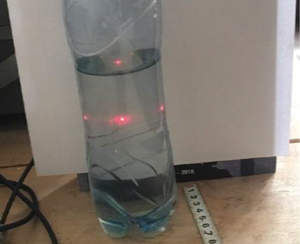Remote identification of liquids in a dielectric container using millimeter waves. 4. Multifrequency scanning
DOI:
https://doi.org/10.3103/S0735272720030012Keywords:
microwave band, multi-frequency radio metrics, brightness temperature, oil processing products, water-alcohol solution, distance identificationAbstract
Application of multi-frequency radiolocation allows to expand essentially received signals spectrum that increases amount of a target (object) classification identifiers including thermal portraits for radiometric measurements. In this paper it is represented a prototype of measuring radiometric unit allowing to carry out simultaneously contactless radiometric research of liquids in two wavelength ranges: 8-mm and 3-mm. It is developed the method of definition of parameters of capacity (container) where liquids are placed. It is estimated an influence of caustics appearing in case of waves reflections from internal wall of container and also on quality factor, attenuation coefficient and relative factor of container which are distantly measured. In two frequency ranges there are carried out researches of two water solutions and oil processing products (gasoline, dissolvents, diesel fuel). It is shown the liquids with close thermal portraits in identical frequency band due to close physical-chemical parameters, can have different thermal portraits obtained in different frequency bands reflecting dispersion properties of the liquids and they can be used for liquids identification visually or in case of received data processing.References
- A. V. Pavlyuchenko, P. P. Loshitskiy, A. I. Shelengovskiy, V. V. Babenko, “Remote identification of liquids in a dielectric container using millimeter waves. 1. Principal possibility,” Radioelectron. Commun. Syst., v.60, n.10, p.423, 2017. DOI: https://doi.org/10.3103/S0735272717100016.
- A. V. Pavlyuchenko, P. P. Loshitskiy, A. I. Shelengovskiy, V. V. Babenko, “Remote identification of liquids in a dielectric container using millimeter waves. 2. Linear scanning,” Radioelectron. Commun. Syst., v.61, n.4, p.157, 2018. DOI: https://doi.org/10.3103/S0735272718040039.
- A. V. Pavlyuchenko, P. P. Loshitskiy, A. I. Shelengovskiy, V. V. Babenko, “Remote identification of liquids in a dielectric container using millimeter waves. 3. Angular scanning,” Radioelectron. Commun. Syst., v.62, n.1, p.12, 2019. DOI: https://doi.org/10.3103/S0735272719010035.
- D. A. Robertson et al., “The CONSORTIS 16-channel 340 GHz security imaging radar,” in Passive and Active Millimeter-Wave Imaging XXI, 2018, vol. 10634, p. 8, doi: https://doi.org/10.1117/12.2304376.
- E. A. Sharkov, Radiometric Distant Probing of Earth: Physical Principles, Vol. 1 [in Russian] (IKI RAN, Moscow, 2014).
- Ya. D. Shirman, V. M. Orlenko, S. A. Selezniov, “Passive raiolocation of hidden radiation,” Systemy Ozbroiennia I Teknika, n.1, p.97. 2005.
- S. Kueppers, S. Wang, H. Cetinkaya, R. Herschel, and N. Pohl, “Imaging characteristics of a highly integrated millimeter wave MIMO radar,” in Proceedings International Radar Symposium, 2018, vol. 2018-June, doi: https://doi.org/10.23919/IRS.2018.8448247.
- Yu. N. Syedyshev, V. A. Tyutyunnik, “Information technologies of creating modems of multi-position active and passive radar systems,” Applied Radio Electron., v.14, n.1, p.105, 2015. URI: http://nbuv.gov.ua/UJRN/Prre_2015_14_1_17.
- I.M. Lifshits, S. A. Gredeskul, L. A. Pastur, Introduction in Theory of Disordered Systems [in Russian] (Nauka, Moscow, 1982).
- V. G. Niz’ev, “Dipole-wave theory of electromagnetic diffraction,” Physics-Uspekhi, v.45, n.5, p.553, 2002. DOI: https://doi.org/10.1070/PU2002v045n05ABEH001091.
- D. Deirmendjian, Electromagnetic scattering on spherical polydispersions. Alpharetta: American Elsevier Pub. Co, 1969.
- V. V. Kotliar, M. A. Lichmanov, “Analysis of diffraction of electromagnetic wave on infinite round cylinder with several homogeneous layers,” Kompyuternaya Optika, n.27, p.26, 2007.
- V. V. Syshchenko, E. A. Larikova, “Scattering of electromagnetic wave on dielectric cylinder in Born’ approximation,” Nauchnyie Vedomosti. Seria Matematika, Fizika, v.38, n.5, p.130, 2015.
- J. Bruce, Curves and Singularities: A Geometrical Introduction to Singularity Theory, 2 ed. CambridgeUniversity Press, 1993.
- R. W. P. (Ronold W. P. King and G. S. Smith, Antennas in Matter: Fundamentals, Theory, and Applications. MIT Press, 1981.
- G. Malenkov, “Liquid water and ices: understanding the structure and physical properties,” J. Phys. Condens. Matter, vol. 21, p. 283101, 2009, doi: https://doi.org/10.1088/0953-8984/21/28/283101.
- W. Benenson, J. W. Harris, H. Stöcker, and H. Lutz, Eds., Handbook of Physics. Springer, 2002.
- T. Hastie, R. Tibshirani, and J. Friedman, The Elements of Statistical Learning, 2 ed. New York: Springer-Verlag, 2009.

Downloads
Published
2020-03-21
Issue
Section
Research Articles

